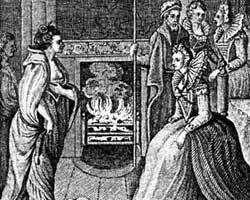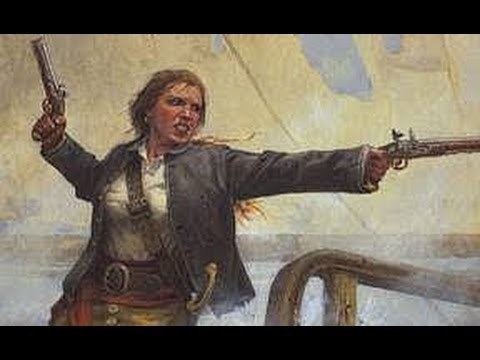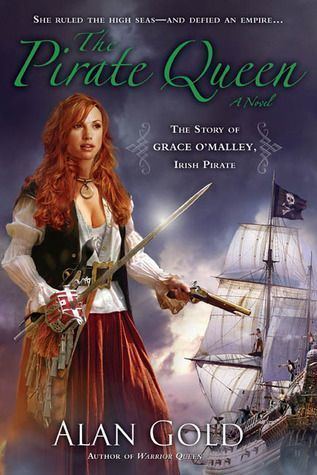Allegiance Ó Máille | Battles and wars Nine Years' War | |
 | ||
Battles/wars Nine Years War (Ireland) Spouse Risdeárd an Iarainn Bourke (m. 1566) Children Tibbot ne Long Bourke, 1st Viscount Mayo, Margaret O'Flaherty Parents Eoghan Dubhdara Ó Máille, Margaret O’Malley Similar Grace Kelly, Anne Bonny, Mary Read, Ching Shih, Calico Jack | ||
Grace O'Malley (c. 1530 – c. 1603; also Gráinne O'Malley, Irish: Gráinne Ní Mháille) was chieftain of the Ó Máille clan in the west of Ireland, following in the footsteps of her father Eoghan Dubhdara Ó Máille. Commonly known as Gráinne Mhaol (anglicised as Granuaile) in Irish folklore, she is a well-known historical figure in 16th-century Irish history, and is sometimes known as "The Sea Queen of Connacht". She was well-educated and regarded by contemporaries as being exceptionally formidable and competent.
Contents
- Early life
- Marriage to OFlaherty
- Marriage to Burke
- Other relationships
- Career
- Legendary exploits
- Revolutionary activity
- Meeting with Elizabeth
- Westport House
- Cultural impact
- References

Her name was rendered in contemporary English documents in various ways, including Gráinne O'Maly, Graney O'Mally, Grainne Ní Maille, Granny ni Maille, Grany O'Mally, Grayn Ny Mayle, Grane ne Male, Grainy O'Maly, and Granee O'Maillie.

Upon her father's death she inherited his large shipping and trading business (a trade sometimes referred to as mere piracy). Through income from this business, land inherited from her mother, and property and holdings from her first husband, Dónal an Chogaidh (Dónal "the warlike") Ó Flaithbheartaigh, O'Malley was very wealthy (reportedly owning as much as 1,000 head of cattle and horses). In 1593, when her sons Tibbot Burke (Tiobóid de Búrca) and Murrough O'Flaherty (Murchadh Ó Flaithbheartaigh), and her half-brother Dónal an Phíopa ("Dónal of the Pipes") were taken captive by the English governor of Connacht, Sir Richard Bingham, O'Malley sailed to England to petition for their release. She formally presented her request to Elizabeth I at her court in Greenwich Palace.

Early life

O'Malley was born in Ireland around 1530, when Henry VIII was King of England and held the title Lord of Ireland. Under the policies of the English government at the time, the semi-autonomous Irish princes and lords were left mostly to their own devices. However this was to change over the course of O'Malley's life as the Tudor conquest of Ireland gathered pace.

Eoghan Dubhdara Ó Máille, her father and his family were based in Clew Bay, County Mayo. He was chieftain of the Ó Máille clan and a direct descendant of its eponym, Maille mac Conall. The Uí Mháille (O'Malleys) were one of the few seafaring families on the west coast, and they built a row of castles facing the sea to protect their territory. They controlled most of what is now the barony of Murrisk in South-West County Mayo and recognised as their nominal overlords the Mac Uilliam Íochtair branch of the Bourkes, who controlled much of what is now County Mayo (the Bourkes (DeBurca) were originally Anglo-Norman but by her lifetime completely Gaelicised). Her mother, Margaret or Maeve, was also a Ní Mháille. Although she was the only child of Dubhdara and his wife, O'Malley had a half-brother called Dónal na Píopa, the son of her father.

The Uí Mháille taxed all those who fished off their coasts, which included fishermen from as far away as England. The head of the family (see Chiefs of the Name) was known simply by his surname as Ó Máille (anglicised as The O'Malley). Local folklore had it that as a young girl O'Malley wished to go on a trading expedition to Spain with her father. Upon being told she could not because her long hair would catch in the ship's ropes, she cut off most of her hair to embarrass her father into taking her. This earned her the nickname "Gráinne Mhaol" (Irish pronunciation: [ˈɡrɑːnʲə veːl]; from maol meaning bald or having cropped hair), usually anglicised as Granuaile. The nickname may also come from "Gráinne Umhaill" ("Gráinne of Umhaill," Umhall being an historical district of west Connacht dominated by the Uí Mháille).
As a child she most likely lived at her family's residence of Belclare and Clare Island, but she may have been fostered to another family since fosterage was traditional among Irish nobility at the time. She was probably formally educated, since she is believed to have spoken in Latin with Queen Elizabeth I in 1593.
Marriage to O'Flaherty
O'Malley was married in 1546 to Dónal an Chogaidh Ó Flaithbheartaigh, tánaiste or heir to the Ó Flaithbheartaigh (O'Flaherty) title, which would have been a good political match for the daughter of the Ó Máille chieftain. As O'Flaherty tánaiste, Dónal an Chogaidh one day expected to rule Iar Connacht, the area roughly equivalent to modern Conamara.
She bore three children during her marriage to Dónal an Chogaidh:
In 1565, Dónal was killed in an ambush while hunting in the hills surrounding Lough Corrib; this was, undoubtedly, part of Dónal's wider struggle with the Joyces for control of Hen's castle on the lough. Gráinne returned to her own lands and established her principal residence on Clare Island. She allegedly took a shipwrecked sailor as her lover. The affair only lasted briefly as he was killed by the MacMahons of Ballyvoy. Seeking vengeance, Gráinne attacked the MacMahon castle of Doona in Blacksod May and killed her lover's murderers on Cahir Island. Her attack on Doona castle earned her the nickname, 'Dark Lady of Doona'.
Marriage to Burke
By 1566, O'Malley had married a second time, this time to Risdeárd an Iarainn ("Iron Richard") Bourke. His nickname may derive from his wearing a coat of mail inherited from his Anglo-Norman ancestors or from his control of the ironworks at Burrishoole, the place of his principal castle and residence.
Traditionally it is said that the Bourke marriage was motivated by O'Malley's desire to enlarge her holdings and prestige. Bourke was owner of Rockfleet Castle, also called Carraigahowley Castle (Carraig an Chabhlaigh - "the rock of the fleet"), strategically situated near Newport, County Mayo, as well as other lands like Burrishoole, with sheltered harbours in which a pirate ship could hide. Bourke was chieftain of a senior branch of his sept, which would eventually make him be eligible for election as Mac William, the second most powerful office in Connacht.
According to tradition the couple married under Early Irish law 'for one year certain', and it is said that when the year was up O'Malley divorced Risdeárd and kept the castle. Legend says that O'Malley and her followers locked themselves in Rockfleet Castle and she called out a window to Burke, "Richard Burke, I dismiss you." Those words had the effect of ending the marriage, but since she was in possession of the castle she kept it. Rockfleet remained for centuries in the O'Malley family and is today open to the public. Despite the divorce story, O'Malley and Bourke are mentioned as husband and wife in English documents of the period, and so appear in English eyes to have remained married, or at least to have been allied. Answering questions from Elizabeth I, O'Malley said she was his widow.
The pair had one son, Tiobóid, nicknamed "Tibbot of the Ships" (Irish: Tiobóid na Long), who was born about 1567. Tibbot was later knighted as Sir Theobald Bourke, and was created 1st Viscount Mayo in 1626 by Charles I of England. Bourke had at least four other children from other marriages: Edmund, Walter, John, and Catherine.
Other relationships
O'Malley was accused of promiscuity and it was said that she may have had a son out of wedlock. Biographer Anne Chambers points out that despite hints at these facts in certain state documents, allegations such as these were frequently made against women who acted in a manner contrary to the social norms of the day.
The Chambers biography relates that the legendary reason for her seizure of Doona Castle in Ballycroy was because the MacMahons, who owned the castle, killed her lover Hugh de Lacy, who was easily fifteen years younger than she was. He was the shipwrecked son of a Wexford merchant and O'Malley had rescued him.
Career
Even as a young woman O'Malley was involved in the business of sailing ships and international trade. She probably learned the business from her father who plied a busy international shipping trade. It is known that she always wanted to join his fleets, but he always refused. Bunowen Castle, where she lived with her first husband, was situated on the most western point in Connacht and was apparently the first base for her shipping and trade activities. By the time of Dónal an Chogaidh's death in the early 1560s she commanded the loyalty of so many O'Flaherty men that many of them left the area when she did and followed her to Clare Island in Clew Bay, where she moved her headquarters.
Her first husband had taken a fortress in the Lough Corrib from the Joyce clan. Because of Dónal an Chogaidh's attitude, the Joyces began calling that particular fortress "Cock's Castle." When they heard of his death, they decided to take back the castle, but O'Malley successfully defended it. It was said that her deportment so impressed the Joyces that they renamed the castle Caisleán na Circe, the "Hen's Castle". It was also said that she successfully defended it against English attack.
Around the time of her first husband's death came the initial complaints to the English Council in Dublin from Galway's city leaders that O'Flaherty and O'Malley ships were behaving like pirates. Because Galway imposed taxes on the ships that traded their goods there, the O'Flahertys, led by O'Malley, decided to extract a similar tax from ships travelling in waters off their lands. O'Malley's ships would stop and board the traders and demand either cash or a portion of the cargo in exchange for safe passage the rest of the way to Galway. Resistance was met with violence and even murder. Once they obtained their toll, the O'Flaherty ships would disappear into one of the many bays in the area.
By the early 1560s, O'Malley had left O'Flaherty territory and returned to her father's holdings on Clare Island. She recruited fighting men from both Ireland and Scotland, transporting the gallowglass mercenaries between their Scottish homes and Irish employers and plundering Scotland's outlying islands on her return trips. In an apparent effort to curry favour with the English, O'Malley went to the Lord Deputy of Ireland and offered two hundred fighting men to serve English interests in Ireland and Scotland.
She attacked ships as far away as Waterford on the south central coast of Ireland and fortresses on the shoreline, including Curradh Castle at Renvyle, the O'Loughlin castle in the Burren and the O'Boyle and MacSweeney clans in their holdings in Burtonport, Killybegs and Lough Swilly.
In 1577, she met with Sir Henry Sidney, the Lord Deputy of Ireland, who already knew of her since she had met his son, Sir Philip Sidney, in 1576. Although Philip Sidney would have been a very young man at the time, O'Malley evidently made an impression on him since he mentioned her in favourable terms to his father. O'Malley was wealthy on land as well as by sea. She inherited her father's fleet of ships and land holdings, as well as the land her mother had owned. Around the time of her meeting with Queen Elizabeth I of England, she owned herds of cattle and horses that numbered at least one thousand, comprising great riches by the standards of the time.
Legendary exploits
Many folk stories about O'Malley have survived. There are also songs and poems about her.
A widespread legend concerns an incident at Howth, which apparently occurred in 1576. During a trip from Dublin, O'Malley attempted to pay a courtesy visit to Howth Castle, home of Lord Howth. However, she was informed that the family was at dinner and the castle gates were closed against her. In retaliation, she abducted the Earl's grandson and heir, Christopher St Lawrence, 10th Baron Howth. He was eventually released when a promise was given to keep the gates open to unexpected visitors and to set an extra place at every meal. Lord Howth gave her a ring as pledge on the agreement. The ring remains in the possession of a descendant of O'Malley and, at Howth Castle today, this agreement is still honoured by the Gaisford St. Lawrence family, descendants of the Baron. (Commemorating these events, there is in Howth a street of 1950s local council housing named 'Grace O'Malley Road'.)
The legendary reason for O'Malley seizure of Doona Castle in Ballycroy was that the MacMahons, who owned the castle, killed her lover, Hugh de Lacy, the shipwrecked son of a Wexford merchant she had rescued. When the guilty members of the MacMahon clan landed on the holy island of Caher for a pilgrimage, O'Malley captured their boats. She and her men then captured the MacMahons and killed those responsible for her lover's death. Still not satisfied with her revenge, O'Malley then sailed for Ballycroy and attacked the garrison at Doona Castle, overpowering the defenders and taking the castle for herself. Her attack against the MacMahons was not the first time she interrupted someone at their prayers. Legend tells of another chieftain who stole property from O'Malley and fled to a church for sanctuary. She was determined to wait out the thief, maintaining that he could starve or surrender. The thief dug a tunnel and escaped, however, and the hermit who took care of the church broke his vow of silence to scold her for attempting to harm someone who had sought sanctuary. Her reply is not recorded.
More than 20 years after her death, an English lord deputy of Ireland recalled her ability as a leader of fighting men, noting the fame she still had among the Irish people.
Revolutionary activity
In 1593, in his letter to protesting O'Malley's claims against him, Richard Bingham claimed that she was "nurse to all rebellions in the province for this forty years". Bingham was Lord President of Connacht, with the task of controlling local lords who had until then been effectively self-governing.
O'Malley had every reason, and used every opportunity, to limit the power of the Kingdom of Ireland over her part of the country. Her castle at Clare Island was attacked by an expedition from Galway led by Sheriff William Óge Martyn in March 1579. However, they were put to flight and barely escaped.
Meeting with Elizabeth
In the later 16th century, English power steadily increased in Ireland and O'Malley's power was steadily encroached upon. Finally, in 1593, when her sons, Tibbot Burke and Murrough O'Flaherty, and her half-brother, Dónal na Píopa, were taken captive by the English governor of Connacht, Sir Richard Bingham, O'Malley sailed to England to petition Elizabeth I for their release. Elizabeth I famously sent O'Malley a list of questions, which she answered and returned to Elizabeth. O'Malley met with Elizabeth at Greenwich Palace, wearing a fine gown, the two of them surrounded by guards and the members of Elizabeth's royal Court. O'Malley refused to bow before Elizabeth because she did not recognise her as the Queen of Ireland. It is also rumoured that O'Malley had a dagger concealed about her person, which guards found upon searching her. Elizabeth's courtiers were said to be very upset and worried, but O'Malley informed the queen that she carried it for her own safety. Elizabeth accepted this and seemed untroubled. Some also reported that O'Malley sneezed and was given a lace-edged handkerchief from a noblewoman. She apparently blew her nose into the handkerchief and then threw the piece of cloth into a nearby fireplace, much to the shock of the court. O'Malley informed Elizabeth and her court that, in Ireland, a used handkerchief was considered dirty and was destroyed. Their discussion was carried out in Latin, as O'Malley spoke no English and Elizabeth spoke no Irish.
After much talk, the two women came to an agreement. Included in the stipulations for each party, Elizabeth was to remove Sir Bingham from his position in Ireland and O'Malley was to stop supporting the Irish lords' rebellions. The meeting seemed to have done some good for Richard Bingham was removed from service. But several of O'Malley's other demands (including the return of the cattle and land that Bingham had stolen from her) remained unmet, and within a rather short period of time Elizabeth sent Bingham back to Ireland. Upon Bingham's return, O'Malley realised that the meeting with Elizabeth had been useless, and went back to supporting Irish insurgents during the Nine Years' War. She most likely died at Rockfleet Castle around 1603, the same year as Elizabeth, though the year and place of her death are disputed.
Westport House
Westport House in County Mayo, Ireland, was the seat of the 11th Marquess of Sligo and his family, direct descendants of O'Malley. The current house was built close to the site of Cahernamart (Cathair na Mart - "fort of the slaughtered cows"), an O'Malley fort. The original house was built by Colonel John Browne, a Jacobite, who was at the Siege of Limerick (1650–51), and his wife Maude Bourke. Maude Bourke was O'Malley's great-great granddaughter.
There is a bronze statue of O'Malley by the artist Michael Cooper – the Marquess of Sligo's brother-in-law – in the grounds of Westport House. Westport House also contains a comprehensive exhibition on the life of O'Malley compiled by author Anne Chambers, a leading authority on Granuaile.
Cultural impact
O'Malley's life has inspired musicians, novelists and playwrights to create works based on her adventures.
